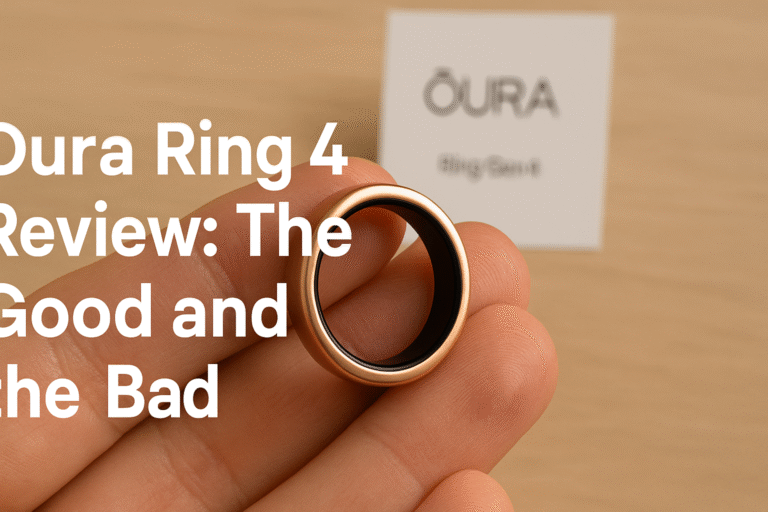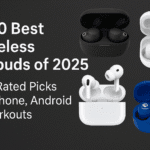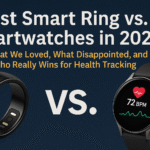Best Smart Ring vs Smartwatches in 2025: Health Tracking Showdown
In this comprehensive guide, we compare the best smart rings and smartwatches of 2025 for health tracking. Discover how smart rings work, key differences vs. smartwatches, and our top picks (with affiliate placeholders) for USA/Canada users. We cover everything from heart rate accuracy and sleep tracking to battery life, and answer common questions in the FAQ below.
Table of Contents
Smart wearables are booming as people seek continuous health insights. Smart rings are small, discreet devices that can monitor your sleep, steps, heart rate, HRV (stress), and more. By 2025 many rings (from Oura to Samsung and Ultrahuman) are pushing the envelope in tracking health, often with a minimal, “wear-and-forget” style. Meanwhile, smartwatches (like the Apple Watch and Galaxy Watch) put a mini-computer on your wrist – offering rich apps, notifications, GPS, and fitness features. Both can help you get healthier, but they shine in different ways. Below, we break down how they compare and list our 10 top picks across rings and watches for health tracking.
Best Smart Ring vs Smartwatch: Key Differences
- Design & Comfort: Smart rings are tiny and lightweight, often just 2–4 grams, making them comfortable 24/7, even while sleeping. Many users report rings as “wear-and-forget” since they don’t buzz or light up in meetings or at night. By contrast, smartwatches are bulkier with a screen and band, which some find intrusive (especially for sleep tracking). As Live Science notes, rings feel “light, discreet and arguably more stylish than chunky wrist-worn wearables”.
- Battery & Charging: Smart rings typically last days without recharging. For example, many rings deliver 4–7 days of battery life on a charge, with some like the RingConn Gen 2 pushing 10–12 days. In practice, rings often outperform watches: Nova Ring reports its ring lasts up to 7 days versus 1–2 days for an Apple Watch. Smartwatches usually need daily or every-2-day charging (unless ultra-saver modes are used). Longer battery on rings means less interruption in tracking and travel-friendly convenience.
- Display & Features: Smartwatches have screens for checking time, alerts, and apps. They can show messages, control music, and run fitness apps on-wrist. Rings have no screen, relying on a paired phone app for feedback. This makes rings simpler but limited: they can’t map running routes (no built-in GPS), auto-detect workouts, or make calls on their own. In other words, watches are all-in-one devices (phone proxy + tracker), while rings focus strictly on “passive” health sensing.
- Health Tracking: Both device types now offer heart rate (HR) and blood oxygen (SpO₂) monitoring, and many support sleep and stress tracking. But how accurate and detailed? Interestingly, rings may have an edge on certain vitals. Optical HR sensors work better on a finger (richer blood vessel network) than on a wrist. A 2022 Frontiers review found finger-based PPG heart-rate readings can be more accurate than wrist-based readings. Rings also put less melanin in the way (palm vs wrist), aiding accuracy for diverse skin tones. However, smartwatches often have more sensors. They can include GPS (for pace), built-in ECG or blood pressure (in higher-end models), and motion detectors for workouts. Rings typically excel at HR variability (HRV) tracking and sleep recovery. For example, many rings compute a “readiness” or recovery score from your HRV, sleep quality and temperature data, giving guidance on rest vs. activity. In contrast, watches tend to focus on active fitness metrics (heart rate zones during exercise, VO₂ max, workout tracking).
- Sleep Tracking: For bedtime monitoring, comfort is king. Most people find rings much more comfortable to wear at night. Light, no-display rings won’t disturb your sleep, and they can gather data all night. A 2024 sleep journal study (meta-analysis) even found many rings underestimate REM sleep a bit (compared to lab measures), but overall rings were more likely to be worn consistently than bulky watches. Many experts point out that rings like Oura are specifically optimized for sleep: they combine motion, HR, skin temp and respiration to assess sleep stages. Smartwatches can track sleep, but comfort issues (and shorter battery) mean fewer people use them overnight.
- Use Cases: In practice, many people use both: a smartwatch for workouts, navigation, and on-wrist alerts, and a smart ring for continuous health monitoring (especially sleep and recovery). For example, one athlete reported using an Apple Watch for daytime running and messages, but switching to a ring for overnight recovery, citing longer battery and holistic insights. Ultimately, the choice depends on your habits: if you want constant, “set-and-forget” health data, a ring is compelling; if you want on-wrist apps, display, and workout features, a watch is better.
- Market & Growth: Smartwatches still dominate wearables – by 2023, ~34% of users had one vs just ~8% for smart rings. But ring adoption is climbing fast. The overall wearable market was $95B+ in 2022 and is forecast to hit ~$149B by 2025. Within that, smart rings are a new frontier: analysts project the global smart ring market will top $1.5 billion in 2025. Health-focused brands (Oura, Samsung, Ultrahuman) are betting big on rings as the next-gen wearables.
Best Smart Ring 2025: Top Picks
Below are our top smart ring recommendations for 2025, highlighting key features. (Affiliate link placeholders [Affiliate] added for USA buyers.)
- Best Smart Ring (Overall): Oura Ring 4 – The industry leader for health tracking. The Oura Ring 4 (US$349 + $5.99/mo subsc) offers exceptional sleep tracking, readiness, and stress insights. Its polished app displays vitals (heart rate, breathing rate, body temp) each day. Wareable calls it “the best wellness tracker out there”. However, it’s the thickest ring and requires a subscription. Its drawbacks: workout tracking is basic and it’s less comfortable than ultra-thin rivals.

- Best Smart Ring without Subscription: RingConn Gen 2 – A slim, subscription-free powerhouse. RingConn Gen 2 (≈$299) is extremely light (2–3g) and just 2mm thick, making it one of the most comfortable rings tested. It boasts an extra-long battery (10–12 days), beating most competitors. Tracking accuracy for sleep and health is solid, and there’s no monthly fee. The trade-off: the app is data-heavy (not as user-friendly), and the matte finish can scratch. Nevertheless, if you want nonstop health data without a subscription, this ring is hard to beat.

- Best Smart Ring for Sleep & Recovery: Ultrahuman Ring Air – Focused on sleep, circadian rhythm, and recovery. The Ultrahuman Ring Air (Gen 2, ~$349) weighs only 2.4g and improves on its predecessor. It emphasizes sleep coaching and daily recovery – its app gives an “Adenosine Clearance Window” to time your caffeine intake and tracks circadian metrics. Ultrahuman also now integrates glucose data (with an add-on) and even hints at AFib detection. No subscription is needed. Downsides: it’s still somewhat chunky compared to rings like Oura, and the app has fewer polish/features. Overall, a strong choice if sleep/recovery data is your priority.
- Best Smart Ring for Workout Tracking: Samsung Galaxy Ring – For Android users, Samsung’s new ring is the standout. The Galaxy Ring (~$399, no sub) nails the basics: sleep scoring, stress, and an intuitive “Energy Score” combining sleep and HRV. Notably, it handled exercise HR better than any other ring in tests. It even offers sleep coaching and chronotypes (animals represent your sleep style). On the flip side, it lacks advanced features on the ring itself – no built-in GPS (take your phone on runs), no ECG or blood pressure sensor. Basically, it’s the Galaxy Watch Ultra’s minimal counterpart. We recommend it for Samsung/Android fans who want a Ring, but it doesn’t do more than Samsung’s own watches, it mostly does less.

- Best Medical Smart Ring: Bodimetrics Prevention Circul+ – For users who need clinical data in a ring form. The Prevention Circul+ (~$299) packs ECG, blood pressure, pulse oximetry, heart rate, and temperature into one device. It’s FDA-cleared for SpO₂ and calibrated with a cuff for accurate BP. Lab comparisons show its HR is within ±2 bpm and SpO₂ within ±3% of medical devices. In short, it’s a mini medical monitor on your finger. The catch: it’s bulky and short on battery (about 16 hours) compared to other rings. It’s best used on-demand for health spot-checks or chronic condition management rather than 24/7 tracking.
- Best Smart Ring for Women: Movano Evie Ring – Tailored to women’s health. The Movano Evie (~$269) is one of few rings focusing on menstrual and women’s metrics. It measures heart rate, HRV, sleep, respiratory rate, temperature and SpO₂, plus lets you log mood and menstrual symptoms to spot patterns. (Movano is seeking FDA clearance for its HR sensor.) The first-gen launch had issues, but the improved Evie aims to address them. It’s slightly larger (3.2–3.7g) but offers a bold, fashion-forward design. If cycle tracking and stress monitoring are priorities, this ring is worth considering once its software matures.
- Best Slim/Light Smart Ring: Circular Ring (Slim) – The lightest & thinnest pick. Circular’s original Ring Slim (~$275) weighs just 2g and is only 2.2mm thick – thinner than Oura or most rivals. It uses a PPG sensor, accelerometer, temperature and BIA. An updated firmware improved its scratch-coating and waterproofing, but the tracking insights are still catching up. The slim design is ultra-comfortable, but the trade-off is a less-polished app and fewer built-in metrics than bigger rings. Circular has since unveiled a Ring 2 with ECG due soon, but in the meantime the Slim is for minimalists who just want basic tracking with minimal bulk.
- Best Budget Smart Ring: Amazfit Helio Ring – A more affordable entry. The Amazfit Helio (~$199) is a titanium 10ATM waterproof ring with core tracking features. It covers the basics (sleep stages, readiness, resting HR, HRV) and syncs to the Zepp Health app. Its app data is more limited than higher-end rings like Oura or Ultrahuman, and it currently lacks its own fall-back notifications (it sends data to your phone). Amazfit even sells sports watches, so the ring’s stats often mimic what its watches do (e.g. sleep metrics). In testing, Helio delivered accurate sleep scores (some testers found it higher than Whoop/Oura/Apple) but fewer actionable insights. Overall, it’s a decent starter ring for under $200, especially if you like Amazfit’s ecosystem.

Best Smartwatches 2025 for Health Tracking
(We include these for comparison, as the category is in the title. Each can be paired with the rings above for best results.)
- Best Smartwatch for iPhone (iOS): Apple Watch Ultra 2 – Apple’s rugged flagship (1.9″ OLED, $799+) has perhaps the best display and battery of any Apple wearable. It tracks everything (HR, SpO₂, ECG, VO2 max, sleep, workouts) and even serves as a diving computer. In TechRadar’s tests it was “the most capable wearable [Apple has] ever made,” with a bright 3000 nit screen and 36h battery. Downsides: it still needs an iPhone for many functions, and it’s large and pricey. But for iPhone owners who want a screen on the wrist (notifications, maps, apps), this is the clear best Apple smartwatch.

- Best Smartwatch for Android: Samsung Galaxy Watch Ultra – Samsung’s top wrist watch (Wear OS) is the Android counterpart to the Apple Ultra. It offers 100h battery, advanced health sensors, GPS, and a rugged build. It supports ECG and BP (with Samsung’s phones), plus all fitness modes. We highlight it because it pairs best with Samsung phones and provides the smartwatch features rings lack. (Samsung also has midrange watches like Watch 6 and 7, but the Ultra is the health king among them.)

- Best Google/Android Watch: Google Pixel Watch 3 – The new Pixel Watch (Wear OS) sports a sleek round design, 36h battery and deep Fitbit/Google integration. TechRadar notes it’s an “absolutely classic” smartwatch design with even brighter display than before. It handles all typical health tracking (HR, SpO₂, sleep, workouts) and works seamlessly with Android phones (especially Pixel devices). If you use Google services and want a watch with a stylish look, the Pixel Watch 3 is the pick.

- Best Wear OS (Non-Google): OnePlus Watch 3 – A great all-rounder with killer battery. The OnePlus Watch 3 (Wear OS 4) delivered 120 hours on tests – unheard of for Wear OS. It has a crisp AMOLED display, rotating crown, and supports Google’s entire app suite. It covers health essentials (HR, SpO₂, exercise, sleep) and even has some new wellness features. It’s a bit larger/heavier, but a good alternative to Pixel (and usually cheaper).

- Best Cheap Smartwatch: Amazfit Active 2 – For a budget, system-agnostic pick, Amazfit’s Active 2 (Zepp OS) impresses. It’s a simple, classic design with full Android/iOS compatibility. It offers 10-day battery life, always-on AMOLED screen and robust health tracking (heart rate, SpO₂, sleep, stress, activity). TechRadar calls it “brilliant classic design” with “excellent health tracking.” At ~$150 it’s a steal if you want basic smartwatch functions without high cost.

- Best Smartwatch for Kids: Verizon Gizmo Watch 3 – A specialized kids’ smartwatch. The Gizmo Watch 3 has a built-in camera, voice calling, video chat, messaging (through a parent-controlled app), GPS tracking and games. It even has an SOS button and parental controls. Battery lasts about 3–4 days. (It requires a Verizon plan.) In short, for elementary/middle-school kids who need safe connectivity, devices like the Gizmo Watch 3 or Xplora XGO3 are the options. The Gizmo was praised by parents for its ease of use and essential functions.
Smart Ring vs Smartwatch: Which Should You Choose?
Ultimately, the “winner” depends on you. If your priority is detailed health insights with zero fuss, a smart ring might be more your style. It works silently in the background (a bit like having a health-monitoring talisman), with excellent comfort and battery life. Rings excel at long-term metrics like HRV and sleep patterns.
If you want on-screen functionality – apps, messages, GPS and active workout modes – a smartwatch wins. It’s like carrying a mini smartphone on your wrist. For fitness junkies or those who need quick notifications and calling, a watch is the clear choice. Many users wear both: a smartwatch for daytime tasks and a smart ring at night for recovery data.
Think of it this way: a smart ring is like a silent health coach nudging you to rest when needed, whereas a smartwatch is like a gym buddy and life assistant strapped to your arm. You don’t always need a gym buddy, but sometimes you do.
Whichever you pick, both ring and watch can significantly improve self-awareness. As Live Science concluded, neither is 100% accurate, but “they can still help you spot patterns in your heart rate and sleep.” In 2025, the smart money is on using whatever combination of devices fits your lifestyle – maybe even both a ring and a watch – so you can stay connected and healthy without missing a beat.
Also Check Out 10 Best Wireless Earbuds of 2025: Unbeatable Sound for iPhone, Android & Fitness
FAQ
Q: What is the best smart ring? It depends on needs. For most, the Oura Ring 4 is the top choice (best sleep/recovery tracking). If you don’t want a subscription, the RingConn Gen 2 is excellent (long battery, low price). For Android users, the Samsung Galaxy Ring offers seamless integration. For women’s health, consider the Movano Evie.
Q: Do smart rings need subscriptions? Not always. Oura requires a monthly plan for full features (≈$6/mo). But brands like RingConn and Ultrahuman offer premium tracking without mandatory subscription. Always check the fine print when buying.
Q: What is the best smart ring without a subscription? The RingConn Gen 2 and Ultrahuman Ring Air stand out here. Both offer comprehensive health/sleep tracking with no ongoing fees and solid accuracy. Amazfit’s Helio ring is another no-sub option, though with more limited data.
Q: Which smartwatch is best for Android phones? Samsung’s Galaxy Watch Ultra is generally the best all-round Android watch. If you use Google services (or a Pixel phone), the Google Pixel Watch 3 is another excellent Wear OS option. For a cheaper pick, the OnePlus Watch 3 offers outstanding battery life on Wear OS.
Q: What is the best smartwatch for iPhone? Unsurprisingly, the Apple Watch Ultra 2 is the top pick for iPhone users. It has the richest health features and smooth integration with iOS. For a budget Apple option, the Apple Watch SE 2 (noted in TechRadar) still covers most core metrics (calls, crash detection, fitness) at lower price.
Q: What is the best children’s smartwatch? Devices like the Verizon Gizmo Watch 3 and Xplora XGO3 are highly rated for kids. They include calling, GPS location, games and parental controls. For example, the Gizmo Watch 3 offers safe voice/video calls and GPS tracking (battery ~3-4 days). These are more kids-friendly than adult smartwatches.
Q: Are smart rings accurate? They’re quite good for trends. Finger-based sensors often match or exceed wrist sensor accuracy for resting heart rate. Rings also reliably measure sleep duration and HRV trends. But no consumer tracker is perfect – factors like loose fit, cold skin or fast movement can skew readings. Experts say use rings to spot patterns in your data, not as clinical devices.
Q: Can a smart ring replace a smartwatch? Generally not completely. A ring can handle long-term health monitoring brilliantly, but it won’t show messages or run apps. Think of rings and watches as complementary. Many health enthusiasts use a ring for 24/7 tracking (sleep, stress, recovery) and a watch for active workouts and connectivity. The “winner” is the one that fits your routine – or using both for best of both worlds.






